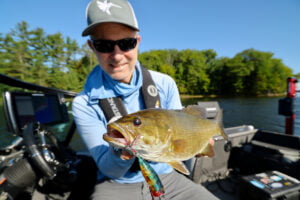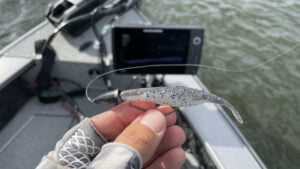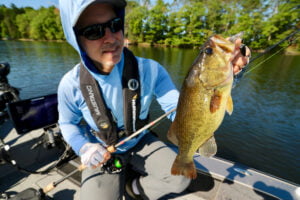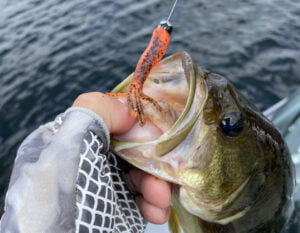Fall is an extraordinary time to be a bass angler. As water temperatures cool from their summer peak, baitfish make predictable changes to their typical locations, and bass – both smallmouth and largemouth alike – respond in kind, following their prey and feeding with urgency. After a long summer that scatters bass across multiple habitats, fall is a time of consolidation, pulling large numbers of fish into more focused locales. At the same time, the bass feeding switch is flipped to “on”, providing anglers with excellent opportunities to catch large numbers of heavyweight fish as the leaves show their first tinges of yellow, crimson and gold. Here are three proven techniques that will put more bass in the boat this fall.
Dr. Jason A. Halfen
Throw poppers near hard cover
Shallow water becomes far more hospitable to baitfish as surface temperatures begin their downward slide, with prey frequently congregating near hard, shoreline-related cover. Bass, of course, are never far behind, and can be found waiting to ambush baitfish near docks and fallen timber. Surface poppers are an excellent way to draw bass into the open, triggering aggressive strikes and providing anglers with an all-encompassing, entirely visual fishing experience.

Dialing in the proper cadence for working a surface popper can quickly become an exercise in interpreting the bass’ mood as dictated by sky conditions, water temperature and general levels of angling pressure. Sometimes, a hearty “chug” followed by a long pause will be effective, especially when calling bass from long distances. At other times, a nervous skitter across the surface that sprays a little water and leaves a distinct bubble trail is best. When working the bait away from cover in open water, a traditional walk-the-dog retrieve can be quite effective. Experimentation is the key; try several different retrieves, being sure to work strike-provoking pauses into each, until you crack the code.
The Mad Max popper from MONSTERBASS is rapidly becoming one of my favorite topwater baits. Mad Max is able to quickly pivot from one retrieve style to another, and to excel at each. The popper is meticulously weighted and balanced, providing excellent casting distance and accuracy – a key attribute when fishing near unforgiving, hard cover. The Feeder Gill color pattern performs well on natural lakes where bluegill are the primary bass forage, while the Bone color pattern really shines on shad-based rivers and reservoirs.

I present poppers using a 7-foot, medium-heavy power, moderate-fast action G. Loomis GCX crankbait rod. Unlike many of the fiberglass crankin’ sticks available today, this G. Loomis GCX rod is fashioned entirely from graphite, taking advantage of over 40 years of rod design and engineering experience to slow the blank’s action. The result is a slender, lightweight rod that delivers laser-precise casts and is a joy to fish. I pair this rod with a 7.1:1 gear ratio Shimano Metanium reel, spooled with 40 pound-test PowerPro braided line in the stealthy Moss Green color. Throw Mad Max with this combo, and you may find yourself fishing that dynamic new popper all day long – with a smile!
Work deep weed edges with Texas rigs
Deep weeds that ring the basin are a frequent stopping point for bass as they work their way toward the shallow water buffet. A primary reason that bass will hold here is that deep weeds are often loaded with food, especially young-of-the-year panfish, as summer turns to fall. This readily available food source, coupled with thick green weed growth, will keep bass in a feeding mood in cooling waters.

While mid-summer anglers often target bass from deep weeds using jigs dressed with soft plastic trailers, fall pulls feeding activity toward deep weed edges. Here, where weed density is reduced, a classic Texas-rigged soft plastic can be fished both efficiently and effectively.
In the fall, I like to present 6” lizards and 5” fluke-style minnows on Texas rigs. These slender, larger profile baits seem to trigger more strikes for me than compact craw imitations or creature baits. I build my rigs using 3/0 or 4/0 wide gap hooks – VMC offset wide gap hooks with resin-closed eyes are excellent choices – and 3/8 oz, pegged bullet weight sinkers with black or unpainted finishes. My rigs have a three-foot leader of 15 pound-test fluorocarbon, joined using an Alberto knot to 30 pound-test PowerPro braided main line.

I’m a big fan of Texas rigging using spinning gear. A 7’1” G. Loomis GCX JWR – short for “Jig-Worm Rod” – with medium power and extra-fast action is a great choice, especially when paired with a C3000 series Shimano Vanford. This is a power-packed, sensitive, and exceptionally well-balanced combo that allows the angler to feel every weed leaf and stem, detect subtle bottom composition changes, and of course, easily detect bites from resident bass.
There’s always room for Ned

Ned Rigs occupy a special place in every bass angler’s bag of tricks, as incredibly reliable partners for putting bass in the boat under tough conditions. A steadily improving bite as the water cools is no reason to put Ned to bed. Indeed, I always have a Ned Rig ready to deploy, as few fish can resist its subtle yet powerful bite triggering capabilities – especially when fished away from cover.

